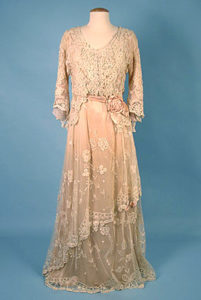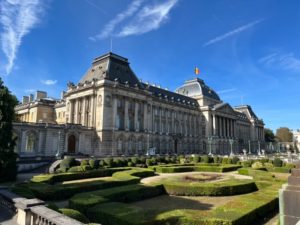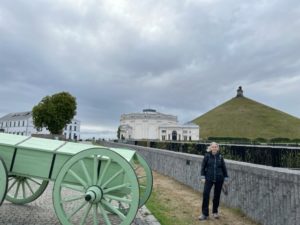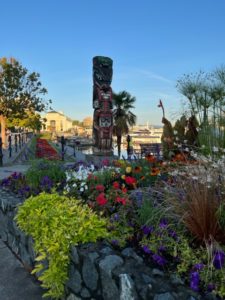Hello everyone!
Last week, both Shannon and Diana talked about their time at the JASNA AGM, and since I was also there, I wanted to share my impressions. As some of you know from Facebook, I was in Belgium earlier in September, too, and I thought I’d make some Jane Austen links to my time there. I have been busy, travel-wise, which I assure you is not the norm, but Belgium was because my darling child is doing a study abroad year there, and her dad and I went to get her settled in (and to have a family holiday). J
We always plan our trips carefully e.g., deciding what museums and other sights we want to visit and creating a rough itinerary. What we didn’t expect was that the day we were flying from Toronto to Brussels, with a planned short—emphasis on short—layover in Dublin would be the day Aer Lingus had a massive IT problem. Sigh. There was stress and chaos, and while I won’t get into all of it, it did mean we found ourselves with a longish layover in Dublin. Rather than stay in the airport, we went downtown for some decent food and to see a bit of the city. It was chilly and rainy (and everything I had packed to accommodate such weather was in my checked bag, because the forecast in Belgium was clear). Still, I managed to get a decent look at a small, small part of the city. (We walked down O’Connell Street, for those of you familiar with Dublin.) I didn’t spot Lady Dalrymple or her daughter, so I suppose they were still in Bath.
Onwards to Belgium we went. I absolutely loved the time I spent in Belgium, and I would be very happy to go back and explore more of it. (Even better, my dear one is very happy there.) I won’t go into everything we did, but rather, I’ll get to the Austen tie-ins.
First, there is Brussels lace. As far as I can tell, Austen never referenced Brussels lace in any of her writing, but she does talk about lace. Brussels lace, which is indeed named after the city, was very popular at Austen’s time, however, and us writers of Austenesque have been known to talk about it. Brussels laces were high quality, richly designed, and were popular in court clothing. I’ve included an example of a gown featuring Brussels lace. (It is from 1914, but it was the best example I could find on a site I go to for copyright-free images. Source: by Sacheverelle, via Openverse, licensed under CC BY 2.0) If you are not familiar with this particular lace, I encourage you to look up examples of it. I am not one for finery (so if you are anticipating seeing photos of me in a Regency gown, give up now—haha), but even I can recognise the beauty and incredible artistry and skill involved in creating this type of lace.
 In Brussels, we saw the Royal Palace. We could not go in, but we stopped to appreciate the outside and take some photos. I imagined Elizabeth becoming accustomed to attending parties of one sort or another at homes such as this. The Royal Palace of Brussels would not have existed in its present form in the early 1800s. Part of the present building is from the late 1700s, but it was only in the early twentieth century that it took the shape and appearance we see today. Like other palaces, it is home to the monarch as well as the site of business, such as receiving official guests.
In Brussels, we saw the Royal Palace. We could not go in, but we stopped to appreciate the outside and take some photos. I imagined Elizabeth becoming accustomed to attending parties of one sort or another at homes such as this. The Royal Palace of Brussels would not have existed in its present form in the early 1800s. Part of the present building is from the late 1700s, but it was only in the early twentieth century that it took the shape and appearance we see today. Like other palaces, it is home to the monarch as well as the site of business, such as receiving official guests.
While we were in Belgium, we took several day trips. The most relevant to this post was Waterloo. We always like to visit sights of historic significance, so it was natural that we would hop on the train to Waterloo. We might have sung the Abba song on the train—but only when no one else could hear us. It is always sobering to stand where something of such great importance took place. Anyone who has read Jane Austen knows how the Napoleonic War was a factor in their lives at the time. What must it have been like to hear about the battle at Waterloo and know that, finally, Napoleon was defeated (granted, it had happened before, and he returned to stage one last attempt for victory)?
this post was Waterloo. We always like to visit sights of historic significance, so it was natural that we would hop on the train to Waterloo. We might have sung the Abba song on the train—but only when no one else could hear us. It is always sobering to stand where something of such great importance took place. Anyone who has read Jane Austen knows how the Napoleonic War was a factor in their lives at the time. What must it have been like to hear about the battle at Waterloo and know that, finally, Napoleon was defeated (granted, it had happened before, and he returned to stage one last attempt for victory)?


We climbed to the top of the Butte de Lion. It marks the allied front line. From there, you can take in the battlefield. I find it impossible not to reflect on the number of people who died during the fighting (estimated at more than 10 000, with tens of thousands more injured), or to wonder how different our lives might be today had the outcome been in favour of the French, not the British and their allies. Who amongst our beloved Austen characters might have fought at Waterloo?
I wanted to buy a little English soldier in the gift shop to be my model of Colonel Fitzwilliam, but they only had Napoleon and French soldiers. Sigh. Who knows what charming, brilliant story centred around the colonel I might have written had I had such an inspiration?
The building in the photo to the right is the visitor centre, which includes a panorama. Panoramas were popular during the very late 1700s and early part of the 1800s. The British front line was along the road.
Enough about Belgium. On to Victoria!
I won’t repeat what Shannon and Diana wrote about the JASNA AGM. I saw a lot of really interesting talks, starting with a special session on fashion by Ivan Sayers. One of the highlights from it was seeing in person how gowns were fastened. Did you know that safety pins were not commonly used until later in the 1800s? (I wrote down 1880s at the time, but I can’t promise I heard correctly.) That means Jane Austen and all the wonderful characters she wrote secured their clothing with straight pins. They must have been very, very careful with their placement, but I imagine it was impossible to avoid getting stuck repeatedly.
One talk I was particularly looking forward to was that by Robert Morrison, author of The Regency Years: During Which Jane Austen Writes, Napoleon Fights, Byron Makes Love, and Britain Becomes Modern (2019). I read the book not long ago and thought it was wonderful—very informative and well written. I’ve used it as a reference for some of my past blog posts, notably when I wrote about same sex relationships in June.
 Something I love about going to the AGMs is hearing new interpretations or speculations about Austen’s works and learning more about the context of the stories i.e., things that would have been obvious to her contemporaries but that we might not know today. Morrison raised some interesting ideas, and ones that I recognise might be controversial. He (and others at the conference) spoke about the men of Sense & Sensibility, questioning which one of them could be considered the hero. Is it Edward Ferrars, who kept his engagement to Lucy Steele secret and did not leave Norland Park when he realised he was growing to care for Elinor (and she for him)? Obviously, it is not Willoughby, despite him being the handsomest man in the book. Then we get to Colonel Brandon, who planned to elope with his cousin and, years later, failed to warn the Dashwoods about Willoughby. I won’t bother to go on with the minor male characters.
Something I love about going to the AGMs is hearing new interpretations or speculations about Austen’s works and learning more about the context of the stories i.e., things that would have been obvious to her contemporaries but that we might not know today. Morrison raised some interesting ideas, and ones that I recognise might be controversial. He (and others at the conference) spoke about the men of Sense & Sensibility, questioning which one of them could be considered the hero. Is it Edward Ferrars, who kept his engagement to Lucy Steele secret and did not leave Norland Park when he realised he was growing to care for Elinor (and she for him)? Obviously, it is not Willoughby, despite him being the handsomest man in the book. Then we get to Colonel Brandon, who planned to elope with his cousin and, years later, failed to warn the Dashwoods about Willoughby. I won’t bother to go on with the minor male characters.
Morrison also highlighted how much Austen alluded to Willoughby finding opportunities to touch Marianne, which was very naughty of him, given the era. From him swooping her up into his arms the first time they met, to his cutting a lock of her hair, and even to his driving them off to visit his aunt’s home when the picnic to Colonel Brandon’s estate was cancelled. By driving quickly in such as small vehicle, it was inevitable that Marianne would cling to him and the movement of the carriage would throw them closer together. As we all know, going to Allenham Court as they did, unchaperoned, was very improper, and it does leave readers scope to wonder just what happened between the couple when they alone. In contrast, when they meet in London, Willoughby does not want to touch her when she offers her hand. A woman shaking a man’s hand was a sign of a close relationship, and he is disavowing her.
I could go on and on about Morrison’s talk (I have many pages of notes from it in my journal), but instead, here are some other interesting tidbits I heard, in no particular order. I knew some of this before, but putting it into the context of Sense & Sensibility was new to me.
- Jane Austen was an admire of Gilpin and the picturesque, but she disapproved of the cult of the picturesque i.e., people overdoing their picturesque sensibility. In Sense & Sensibility, Marianne would seem to fall into the group that went a bit too far with their devotion to the picturesque, whereas Edward Ferrars speaks out against the excesses of the movement when he talks about not liking everything in old or new order. The “old” was the very orderly, geometric, formal landscape and garden design, which was abandoned to the “new” less outwardly orderly picturesque (although it was planned to look ‘natural’ rather than being what we might think of as truly natural).Interestingly, in the picturesque, there was a particularly fondness for groupings of three, and paintings following this style might have three cows together, to give you one example. It is no mistake in Pride & Prejudice when the garden path at Netherfield is only wide enough for three, and when Elizabeth says that Darcy, Mrs Hurst, and Miss Bingley are “charmingly group’d, and appear to uncommon advantage. The picturesque would be spoilt by admitting a fourth” she is referring to preference for triples.
- Colonel Brandon earned a significant amount of money working for the East India Company. I have never really considered exactly what he did while in India. Although many of us think of him as an upstanding gentleman, like a number of Austen’s male characters, he might lose some of the shine from his suit of armour if we dig into his character a bit further. The East India Company’s mission, as I understand it, was to extract wealth from the country. What did Colonel Brandon do to help the company accomplish this goal?
- Finally, there is the question of information and information literacy. Any reader of Austen knows the importance of accurate and timely information and that Austen sometimes withheld information to add to the drama e.g., that Wickham was a cad or Willoughby was the father of Eliza William’s child. How was a young woman to become information literate? Newspapers were largely read by men, although women did also look at them. For example, they might read the announcements to see who was lately married. There are examples of Marianne doing this, as well as Mrs Jennings, Mrs Bennet in Pride & Prejudice, and in Persuasion, this is how Anne Elliot keeps up with Captain Wentworth’s career. ‘News’ could also be gossip, and we know there are some ladies (Mrs Bennet comes to mind) who like to ‘share news’ with their neighbours. This, of course, is often inaccurate and can lead to misunderstandings. Mrs Jennings eavesdrops on Elinor and Colonel Brandon’s conversation to gather the ‘news’, and mistakenly believes they are engaged.Letters are another chief source of information for women, and we know there are a lot of letters in Austen’s books. Indeed, they are very important in the novels. Who can forget Captain Wentworth’s letter to Anne? (Fun fact, I once got a friend hooked on Austen by having her read the letter.) And in Pride & Prejudice we have Mr Darcy’s letter to Elizabeth after the disastrous proposal at Hunsford, and Jane’s delayed letters informing Elizabeth of Lydia’s elopement. Had Jane’s letters arrived sooner, Elizabeth and Mr Darcy might not have encountered each other, and their reconciliation, along with Jane and Mr Bingley’s, might not have taken place. These few examples show how important letters can be for imparting information, as well as how unreliable letters can be in delivering the news in a timely fashion.
There was more I learned, of course, but these are some highlights. I am very glad I had the opportunity to go to the AGM. Information-wise, it exceeded my expectations, and when I was not feeding my Jane Austen loving brain, I was taking in as much of the city as I could. Victoria is beautiful. It was the National Day for Truth and Reconciliation when I was there. I previously wrote about it in my post on Indigenous people being in Britain during Jane Austen’s lifetime. Victoria’s rich Indigenous history was evident in the historic centre, where the AGM was held, and I was happy to go on a First Nations focused tour on 30 September.
During one lunch break, I rushed to the Robert Bateman Gallery. I do not know a lot about contemporary art; however, I am familiar with and a great admirer of Bateman’s work. Being a nature lover myself, his portrayals of wildlife and landscapes are wonderful to me.
I also went to Beacon Hill park, because if there is a park I can visit, I will. J The weather was beautiful, as was the view from the top of the hill. The spindle in the photo to recognise that what is today the park was (and remains) a sight of importance to the local First Nations peoples. There are a number of these markers throughout Victoria, and they provide a way to educate people about the city’s history.
 And there you have it. I am happy to be home again. Between going six hours one way then, a week after returning to Toronto, three hours the other way, it took me a while to sort out which time zone I was in (haha), but I am fully recovered from my excellent travels and hard at work. I won’t tell you what exactly I’m working on, but if you keep an eye on social media, you’ll get a hint in about a month.
And there you have it. I am happy to be home again. Between going six hours one way then, a week after returning to Toronto, three hours the other way, it took me a while to sort out which time zone I was in (haha), but I am fully recovered from my excellent travels and hard at work. I won’t tell you what exactly I’m working on, but if you keep an eye on social media, you’ll get a hint in about a month.
Have a wonderful day!
Lucy <3
https://www.britannica.com/art/Brussels-lace
https://www.seat61.com/places-of-interest/battle-of-waterloo.htm
https://www.history.com/topics/british-history/battle-of-waterloo

12 comments
Skip to comment form
Wonderful narration of your travel adventures, Lucy – my goodness you did a lot, including that inadvertant side visit to Dublin! Loved seeing Belgium through your eyes. Also, wasn’t it interesting how each of the three of us Austen Variations authors who spent time in Victoria at the AGM, had such a variety of experiences – and we all so thoroughly enjoyed them. We might almost have been at different conferences, for the different things we did and saw, so it really wasn’t “wonderful” (in the Austen sense) that you and I somehow never did manage to meet up! Next year in Denver, though!
That’s so very true, Diana. I think one thing I learned this year was that it’s best to make a plan to meet up with people ahead of time. Once at the AGM, there is just so much going on, the time passes very quickly!
I’m looking forward to Denver. 🙂
You HAVE been busy! Lovely article, Lucy. I really enjoyed sharing in your travels.
Author
Busy? Me? Haha. Maybe just a little. 😀 Thanks, Debbie.
A lovely post, Lucy! I was at the AGM, but there were so many different options–it’s great to hear more of the things I missed!
Author
Hi Brenda! I feel the same way–there was so much I didn’t get to see or do, including meeting more people, such as you. 🙂
Thanks for the tour of your travels, Lucy! So lovely to meet you at the AGM, although much too briefly.
Author
It was nice to meet you too. 🙂
What a wonderful post, Lucy! I felt I was traveling the world with you. (By the way, it’s a shame you couldn’t find your Colonel Fitzwilliam at Waterloo, but I’m absolutely confident you can write a great story about him anyway! :-D)
Thank you also for sharing so much of what you learned about S&S at the AGM. The question about Colonel Brandon is a potent one. I’ve thought about that a great deal, especially as I was writing him in The Year in Between. While I can’t say what Austen’s version of him would have felt, I did feel that my version of Brandon had to acknowledge his own role in that business. I don’t think he would have seen himself as a hero, that’s for sure. (But I love him still!)
I’m so glad you had such enriching experiences, Lucy! Thank you again for sharing them with us.
Author
I think that the best heroes are the ones that do not see that quality in themselves. We will never know what Austen intended for Colonel Brandon or any of her other characters, but I sure do have a lot of time getting into their heads and playing with possibilities. 🙂
Thanks for reading my wee travelogue, Christina. 🙂
Beautiful pictures and such a wonderful travelogue, Lucy. Thanks so much for the summary of Morrison’s talk; I’ve so enjoyed his books.
Author
I really enjoyed getting to see Morrison in person. I was excited about it beforehand, and (for me), his talk lived up to my anticipation. He’s currently a prof at my spouses alma mater. 🙂